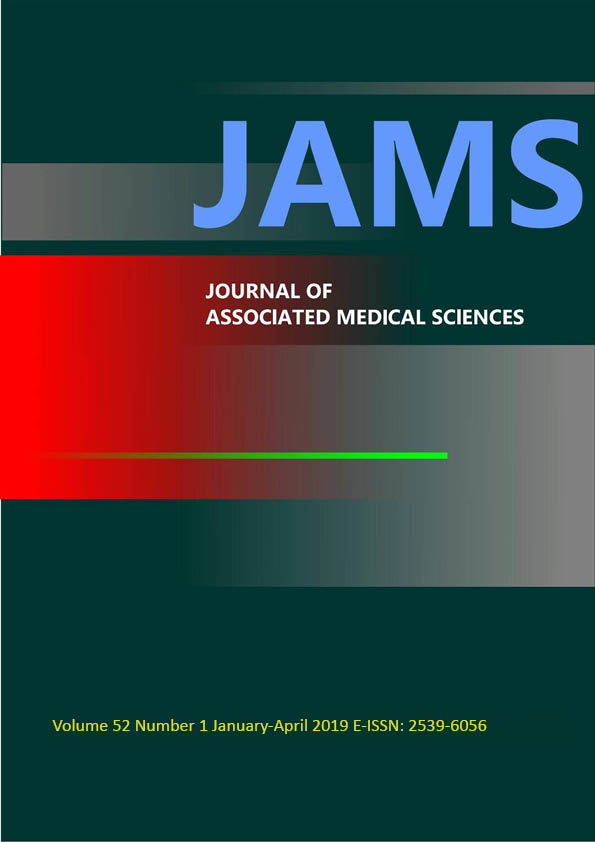A prototype of automatic mattress turning device for pressure ulcer prevention
Main Article Content
Abstract
Background: Pressure ulcer is a major health care problem in bed ridden patients. One of preventive measures is repositioning every 2 hours which is a burden workload on a caregiver.
Objectives: The study aimed to develop and test a laboratory prototype of the automatic mattress turning device (AMTD) whether it could turn one side of the mattress and reposition a patient in a hospital bed as suggesed by the National Pressure Ulcer Advisory Panel (NPUAP).
Materials and methods: A laboratory prototype of AMTD consisted of a set of air bellows and controller. Air bellows were placed under a mattress. An air pump and solenoid valve are controlled by a microcontroller to inflate and deflate the air bellows for turning the mattress, thus reposition from supine to a 30° side-lying or lateral turn position as recommended by NPUAP. Duration for each position can be adjusted from 0 - 120 minutes. A 3-day test was conducted with different duration of turn with bed head tilted at 0° and 30°.
Results: The test revealed that AMTD can provide accurate turning positions and durations of each position. In addition, it worked efficiently when head of bed was lifted up at 30°.
Conclusion: AMTD could turn a hospital mattress and assist with patient repositioning. Further development for commercial use would lead to a new device for pressure ulcer prevention.
Article Details

This work is licensed under a Creative Commons Attribution-NonCommercial-NoDerivatives 4.0 International License.
Personal views expressed by the contributors in their articles are not necessarily those of the Journal of Associated Medical Sciences, Faculty of Associated Medical Sciences, Chiang Mai University.
References
[2] National pressure ulcer advisory panel (NPUAP). Prevention and treatment of pressure ulcers: quick reference guide [Internet]. Osborne Park, Western Australia; 2014 [cited 2017 Dec 17]. Available from: https://www.npuap.org/wp-content/uploads/2014/08/Updated-10-16-14-Quick-Reference-Guide-DIGITAL-NPUAP-EPUAP-PPPIA-16Oct2014.pdf
[3] Xakellis GC, Frantz R, Lewis A. Cost of pressure ulcer prevention in long-term care. J Am Geriatr Soc 1995; 43(5): 496-501.
[4] Bennett G, Dealey C, Posnett J. The cost of pressure ulcers in the UK. Age Ageing 2004; 33: 230-5.
[5] Markova A, Mostow EN. US skin disease assessment: ulcer and wound care. Dermatol Clin 2012; 30(1): 107-11.
[6] Thomas DR, Goode PS, Tarquine PH, Allman RM. Hospital-acquired pressure ulcers and risk of death. J Am Geriatr Soc 1996; 44: 1435-40.
[7] Kammuang-lue P, Kovindha A. A 3-year retrospective study on total admission charge of spinal cord injured patients with pressure ulcer at rehabilitation ward, Maharaj nakorn Chiang mai hospital. J Thai Rehabil Med 2012; 22(2): 58-63 (in Thai).
[8] Le Fort M, Espagnacq M, Perrouin-Verbe B, Ravaud JF. Risk analyses of pressure ulcer in tetraplegic spinal cord-injured persons: A French long-term survey. Arch Phys Med Rehabil 2017; 98(9): 1782-91.
[9] Stevenson R, Collinson M, Henderson V, Wilson L, Dealey C, McGinnis E, et al. The prevalence of pressure ulcers in community settings: an observational study. Int J Nurs Stud 2013; 50(11): 1550-7.
[10] Russell T, Logsdon A. Pressure ulcers and lateral rotation beds: A case study. J WOCN 2003; 30: 143-5.
[11] Marini I. The freedom bedTM-comparative costs [Internet]. Abbotsford, British Columbia Canada; 2016. [cited 2017 Nov 28]. Available from: https://www.pro-bed.com/files/File/probed_Comparative-Costs-vs-Alternatives.pdf


